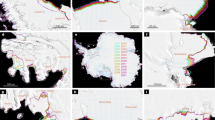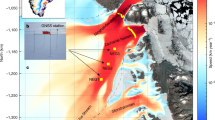Abstract
Many glaciers along the margins of the Greenland and Antarctic ice sheets are accelerating and, for this reason, contribute increasingly to global sea-level rise1,2,3,4,5,6,7. Globally, ice losses contribute ∼1.8 mm yr-1 (ref. 8), but this could increase if the retreat of ice shelves and tidewater glaciers further enhances the loss of grounded ice9 or initiates the large-scale collapse of vulnerable parts of the ice sheets10. Ice loss as a result of accelerated flow, known as dynamic thinning, is so poorly understood that its potential contribution to sea level over the twenty-first century remains unpredictable11. Thinning on the ice-sheet scale has been monitored by using repeat satellite altimetry observations to track small changes in surface elevation, but previous sensors could not resolve most fast-flowing coastal glaciers12. Here we report the use of high-resolution ICESat (Ice, Cloud and land Elevation Satellite) laser altimetry to map change along the entire grounded margins of the Greenland and Antarctic ice sheets. To isolate the dynamic signal, we compare rates of elevation change from both fast-flowing and slow-flowing ice with those expected from surface mass-balance fluctuations. We find that dynamic thinning of glaciers now reaches all latitudes in Greenland, has intensified on key Antarctic grounding lines, has endured for decades after ice-shelf collapse, penetrates far into the interior of each ice sheet and is spreading as ice shelves thin by ocean-driven melt. In Greenland, glaciers flowing faster than 100 m yr-1 thinned at an average rate of 0.84 m yr-1, and in the Amundsen Sea embayment of Antarctica, thinning exceeded 9.0 m yr-1 for some glaciers. Our results show that the most profound changes in the ice sheets currently result from glacier dynamics at ocean margins.
This is a preview of subscription content, access via your institution
Access options
Subscribe to this journal
Receive 51 print issues and online access
$199.00 per year
only $3.90 per issue
Buy this article
- Purchase on Springer Link
- Instant access to full article PDF
Prices may be subject to local taxes which are calculated during checkout




Similar content being viewed by others
References
Joughin, I. et al. Continued evolution of Jakobshavn Isbrae following its rapid speedup. J. Geophys. Res. 113 10.1029/2008JF001023 (2008)
Rignot, E. & Kanagaratnam, P. Changes in the velocity structure of the Greenland ice sheet. Science 311, 986–990 (2006)
Scambos, T. A., Bohlander, J. A., Shuman, C. A. & Skvarca, P. Glacier acceleration and thinning after ice shelf collapse in the Larsen B embayment, Antarctica. Geophys. Res. Lett. 31 10.1029/2004GL020670 (2004)
Krabill, W. et al. Greenland ice sheet: increased coastal thinning. Geophys. Res. Lett. 31 10.1029/2004GL021533 (2004)
Pritchard, H. D. & Vaughan, D. G. Widespread acceleration of tidewater glaciers on the Antarctic Peninsula. J. Geophys. Res. 112 10.1029/2006JF000597 (2007)
Sole, A., Payne, T., Bamber, J., Nienow, P. & Krabill, W. Testing hypotheses of the cause of peripheral thinning of the Greenland Ice Sheet: is land-terminating ice thinning at anomalously high rates? Cryosphere 2, 205–218 (2008)
Scott, J. B. T. et al. Increased rate of acceleration on Pine Island Glacier strongly coupled to changes in gravitational driving stress. Cryosphere 3, 125–131 (2009)
Meier, M. F. et al. Glaciers dominate eustatic sea-level rise in the 21st century. Science 317, 1064–1067 10.1126/science.1143906 (2007)
Vieli, A., Funk, M. & Blatter, H. Flow dynamics of tidewater glaciers: a numerical modelling approach. J. Glaciol. 47, 595–606 (2001)
Schoof, C. Ice sheet grounding line dynamics: steady states, stability and hysteresis. J. Geophys. Res. 112 10.1029/2006JF000664 (2007)
Bindoff, N. L. et al. in Climate Change 2007: The Physical Science Basis (eds Solomon, S. et al.) 385–432 (Cambridge Univ. Press, 2007)
Wingham, D., Shepherd, A., Muir, A. & Marshall, G. J. Mass balance of the Antarctic ice sheet. Phil. Trans. R. Soc. A 364, 1627–1636 (2006)
Rignot, E. et al. Recent Antarctic ice mass loss from radar interferometry and regional climate modelling. Nature Geosci. 1, 106–110 (2008)
Velicogna, I. & Wahr, J. Acceleration of Greenland ice mass loss in spring 2004. Nature 443, 329–331 (2006)
Zwally, H. J. et al. Mass changes of the Greenland and Antarctic ice sheets and shelves and contributions to sea-level rise: 1992–2002. J. Glaciol. 51, 509–527 (2005)
Davis, C. H., Yonghong, L., McConnell, J. R., Frey, M. M. & Hanna, E. Snowfall-driven growth in East Antarctic ice sheet mitigates recent sea-level rise. Science 308, 1898–1901 (2005)
Reeh, N., Mohr, J. J., Madsen, S. N., Oerter, H. & Gundestrup, N. S. Three-dimensional surface velocities of Storstrømmen glacier, Greenland, derived from radar interferometry and ice-sounding radar measurements. J. Glaciol. 49, 210–219 (2003)
Howat, I. M., Joughin, I. R. & Scambos, T. A. Rapid changes in ice discharge from Greenland outlet glaciers. Science 315, 1559–1561 (2007)
Liu, H. X., Jezek, K. C. & Li, B. Development of Antarctic DEM by integrating cartographic and remotely sensed data: a GIS-based approach. J. Geophys. Res. 104, 23199–23213 (1999)
Thomas, R. et al. Accelerated sea-level rise from West Antarctica. Science 306, 255–258 (2004)
Rignot, E. & Jacobs, S. S. Rapid bottom melting widespread near Antarctic ice sheet grounding lines. Science 296, 2020–2023 (2002)
Helsen, M. M. et al. Elevation changes in Antarctica mainly determined by accumulation variability. Science 320, 1626–1629 (2008)
Smith, B. E., Bentley, C. R. & Raymond, C. F. Recent elevation changes on the ice streams and ridges of the Ross Embayment from ICESat crossovers. Geophys. Res. Lett. 32 10.1029/2005GL024365 (2005)
Rignot, E. & Thomas, R. H. Mass balance of polar ice sheets. Science 297, 1502–1506 (2002)
Joughin, I. & Tulaczyk, S. Positive mass balance of the Ross Ice Streams, West Antarctica. Science 295, 476–480 (2002)
Joughin, I., Tulaczyk, S., Bindschadler, R. & Price, S. F. Changes in west Antarctic ice stream velocities: observation and analysis. J. Geophys. Res. 107 10.1029/2001JB001029 (2002)
Shepherd, A., Wingham, D. & Rignot, E. Warm ocean is eroding West Antarctic ice sheet. Geophys. Res. Lett. 31 10.1029/2004GL021106 (2004)
Rignot, E. Changes in ice dynamics and mass balance of the Antarctic ice sheet. Phil. Trans. R. Soc. Lond. A 364, 1637–1655 (2006)
Shepherd, A., Wingham, D., Payne, T. & Skvarca, P. Larsen ice shelf has progressively thinned. Science 302, 856–859 (2003)
Abshire, J. B. et al. Geoscience Laser Altimeter System (GLAS) on the ICESat Mission: on-orbit measurement performance. Geophys. Res. Lett. 32 10.1029/2005GL024028 (2005)
Zwally, H. J. et al. GLAS/ICESat L2 Antarctic and Greenland Ice Sheet Altimetry Data V028. Boulder, CO: National Snow and Ice Data Center 〈http://nsidc.org/data/gla12.html〉 (2007)
Acknowledgements
We are extremely grateful to the ICESat science team and all those at NASA involved in producing the ICESat data products distributed through the US National Snow and Ice Data Center. This work was funded by the UK Natural Environment Research Council.
Author Contributions H.D.P. designed the research; H.D.P. and R.J.A. performed the research; L.A.E. compiled velocity data; H.D.P., R.J.A. and D.G.V. analysed the data; H.D.P. wrote the paper.
Author information
Authors and Affiliations
Corresponding author
Supplementary information
Supplementary Information
This file contains Supplementary Methods, Supplementary Figures 1-10 with Legends, Supplementary Tables 1- 6 and Supplementary References. Supplementary Tables 2 and 4 and Supplementary Figure 8 were replaced on 14th October, 2009. (PDF 2669 kb)
Rights and permissions
About this article
Cite this article
Pritchard, H., Arthern, R., Vaughan, D. et al. Extensive dynamic thinning on the margins of the Greenland and Antarctic ice sheets. Nature 461, 971–975 (2009). https://doi.org/10.1038/nature08471
Received:
Accepted:
Published:
Issue Date:
DOI: https://doi.org/10.1038/nature08471
This article is cited by
-
Monitoring Earth’s climate variables with satellite laser altimetry
Nature Reviews Earth & Environment (2024)
-
Firn on ice sheets
Nature Reviews Earth & Environment (2024)
-
Sea level rise from West Antarctic mass loss significantly modified by large snowfall anomalies
Nature Communications (2023)
-
Mass Balances of the Antarctic and Greenland Ice Sheets Monitored from Space
Surveys in Geophysics (2023)
-
Response of the East Antarctic Ice Sheet to past and future climate change
Nature (2022)
Comments
By submitting a comment you agree to abide by our Terms and Community Guidelines. If you find something abusive or that does not comply with our terms or guidelines please flag it as inappropriate.



